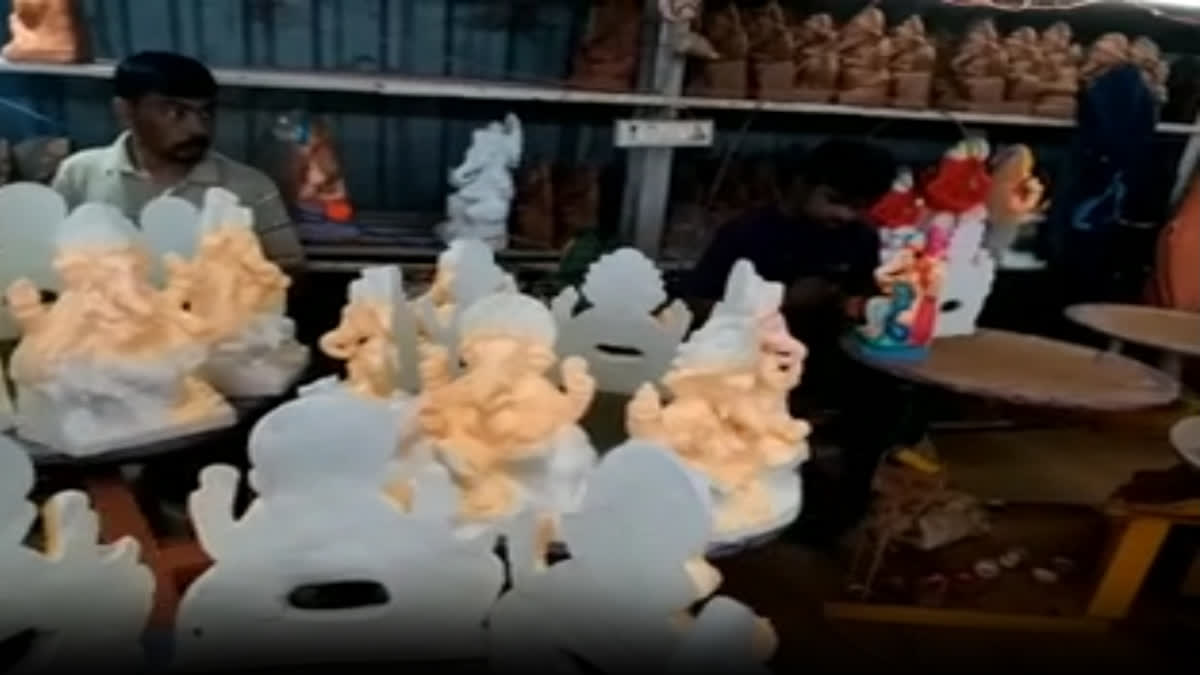Belagavi (Karnataka): A potter family from Belagavi district of Karnataka has been engaged in making Ganesha idols for six decades. This time over three lakh Ganapati idols have been made.
It is special that this potter's family has made Ganesha idols their profession for decades to keep the word given to their grandfather. Another special feature is that all Ganapati idols are also made from eco-friendly clay.
The family of Shankarappa Mallappa Kumbara of Konnuru town of Gokak tehsil is known for making Ganesha idols. This work, which started with making only 40 idols, has grown to the point of making over three lakh idols.
In 1962, the late Shankarappa Mallappa Kumbara along with his son-in-law late Siddappa Kenchappa Kumbara and kin set up Sri Kadasiddeshwara Ittangi and Kumbarike Manufacturers Co-operative Society. Shankarappa, who started his pottery career through this association, advised his six children to make Ganesha idols in six sections. The children, who obeyed their father's word without fail, are continuing their clan craft even today.
After that, the potter's family, which progressed step by step, built six massive units and made idols individually under the association. The idols are being sold at various places in the state including Bengaluru, Bidar, Chamarajanagar, Mysore, Hassan, Hubballi, and Dharwad. Besides, they are also supplying idols to neighbouring states of Maharashtra and Goa.
And as the industry grew, the potter's family also grew, and the family that had six children then has 60 members today. All of them are shareholders of this association. Another speciality of this place is that idols are made throughout the year.
How to make the idol?:The red soil of the hill is collected from Ramganatti, Hatti Alura, Gudketara and other villages near Pashchapur of Gokak tehsil and kept outside in the sun and air for a year. Then the soil is crushed and the stones are separated. Then the soil is powdered by putting it in a pulverizer machine. That powder is put in a square block and soaked it in water for 24 hours. After this, the soil is trampled with the feet to make it soft and dried in the shade. At this time, the cotton is mixed. The next day, after mixing properly in the pug mill machine, the softened clay is put into the moulds of respective sizes and Ganesha idols are made.
Use of natural dyes:Konnur potters do not use dyes that are harmful to the environment. After the idols are prepared and given their final shape, they are dried well for 15 days. Then they are polished. The idols are first painted with natural white and then decorated with various colours suitable. Once again they are dried and packed and finally delivered to the customers.
Graduates involved in idol making:Idol maker Suresh Mallappa Kumbara told ETV Bharat that he was a B.Sc graduate. "My other brothers, who have studied BE Mechanical, B.Ed, B.Com, B.E.M.S, also make idols. It was our grandfather's wish that we should not go elsewhere in search of a job after learning and we should be able to provide employment to people where we are. Accordingly, everyone is continuing the same work. Besides, we have given employment to around 400 people," he claimed.
Muslims also help in idol making: Association president Sankara Appanna Kumbara said, that women, youth and elderly, work to make idols. "We have also given opportunity to disabled people. We do not discriminate against any caste or religion. Muslims also work with us diligently," he signed off.
Also read:Ganesh festival special: 12 lakh American Diamond Ganapati prepared in Hubli
Also read:Karnataka: Court refuses to stay Ganesh Chaturthi celebrations at Hubbali-Dharwad's Idgah ground
